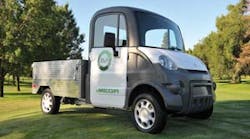Light duty electric vehicles for the commercial industry have advanced into a reliable and marketable product. Electric vehicles are being manufactured in multiple configurations and for diverse applications. The evolution of electric vehicle technology is ever going forward, and developments make electric traction technology already suitable for many applications.
(Resources that were most helpful in providing information and material for this article included Yaron Vorona, TREM Center Director, Institute for the Analysis of Global Security; the Electric Drive Transportation Association; and Robert Stüssi, mobility consultant and president of the European Association for Battery, Hybrid and Fuel Cell Electric Vehicles, and vice president of the World Electric Vehicle Association.)
Battery electric vehicles, by way of example are especially well-suited for vehicle fleets with predictable travel routes and centralized refueling options. Plug-in hybrid and extended range battery electric vehicles provide additional range and flexibility in uses that require longer or more unpredictable routes.
Companies like UPS, FedEx, Coca-Cola, PepsiCo and Walmart use hybrid electric vehicles in their fleets. The federal government is already investing in electric drive, and will have a fleet or some 11,000 hybrid cars and trucks by the end of the year.
In non-road applications, electric vehicles (EVs) and electric-powered equipment fleets are becoming increasingly common. At airports across the U.S., electricity fuels the electric baggage tugs moving baggage between the terminal and aircraft; the baggage belt loaders that load and unload bags from aircraft; the air stairs for passenger access to aircraft; wheelchair lifts and pushback tractors to move aircraft away from the terminal.
Battery electric vehicles, such as lift trucks and personnel carriers, are widely used on school campuses, in planned communities, resorts, large business complexes and by government agencies. Also, most sweepers and scrubbers in use today are electric.
Economic and environmental factors are the top reasons fleets are considering electric-powered alternatives to vehicles that run on conventional fuels such as gasoline and diesel. EVs generally have a lower total cost of ownership than internal engine-powered vehicles, even in cases where the initial purchase price is for the time being substantially higher.
EVs give performance benefits because their electric motors provide quiet, smooth and more energy-efficient operation than internal combustion engines.
Additional energy and fuel savings are available from electric vehicles that incorporate power-conserving technologies like regenerative braking. With this type of braking, the kinetic energy normally dissipated during braking is recovered and this energy is stored in the vehicle’s batteries
Because they are powered by electricity, electric vehicles help reduce U.S reliance on foreign oil. It would be important to assure that electricity be produced by renewable energies, though well-to-wheel energy use show benefits for EVs even if electricity is made from coal.
Well-to-wheel is an analysis to assess the impact of fuel and powertrain options on energy use and greenhouse gas emissions.
With fewer moving parts, EVs requires less periodic maintenance, are more reliable and incur lower maintenance costs. This is why nearly every elevator in the country uses an electric motor.
While gas-powered vehicles have hundreds of moving parts, the electric motor has one moving part, the shaft, which is very reliable and requires little or no maintenance, says the U.S. Department of Energy. The controller and charger are electronic devices with no moving parts, and they require little or no maintenance as well.
On the other hand, EVs face some significant challenges. Present obstacles include driving range before the need to recharge; recharge time; battery cost; battery bulk and weight; and battery life.
MAIN TYPES
Basically, there are four main types of electric vehicles:
- Pure electric vehicles, also known as battery electric vehicles (BEV).
- Hybrid vehicles (HEV).
- Plug-in hybrid electric vehicles (PHEV).
- Fuel cell vehicles (FCEV).
Battery electric vehicles: These use batteries to power an electric motor to propel the vehicle. This produces no tailpipe emissions. The batteries are recharged from the electric grid, as well as from regenerative braking.
There are several challenges with this type of EV. Among them: improving battery technology to lower costs, increased energy density and extended durability; possible need for more recharging infrastructure; and extending the mileage range.
Hybrid electric vehicles: These are powered by both an electric motor and an internal combustion engine, independently or jointly (serial or parallel hybrid). A hybrid is designed to capture energy that is normally lost through braking and coasting to recharge the batteries (regenerative braking), which in turn powers the electric motor. There is no need to plug this type of vehicle in.
With a parallel hybrid electric vehicle, both the internal combustion engine and the electric motor generate the power that drives the wheels. Parallel hybrids can use a smaller battery pack and, therefore, rely mainly on regenerative braking to keep it recharged. However, when power demands are low, parallel hybrids also utilize the drive motor as a generator for supplemental recharging, much like an alternator in conventional cars.
A series hybrid electric vehicle is the simplest hybrid configuration. It uses an electric motor to provide added power to the internal combustion engine when it needs it most, for example, in stop-and-go driving and acceleration.
Along with giving performance benefits and reducing
U.S reliance on foreign oil, electric vehicles requires less periodic maintenance, are more reliable and incur lower maintenance costs.
Hybrid electric vehicles may need more maintenance than a typical vehicle since there are two propulsion systems – the regular one and the electric one.
Plug-in hybrid electric vehicles: Like hybrid electric vehicles, plug-in hybrid electric vehicles (PHEVs) are powered by two energy sources: an energy conversion unit, such as an internal combustion engine or fuel cell, and an energy storage device, usually batteries.
The energy conversion unit can be powered by gasoline, diesel, compressed natural gas, hydrogen or other fuels. The batteries can be charged by plugging into a standard 110-volt electrical outlet – a capability conventional battery electric vehicles do not usually have, or may be charged by the energy conversion unit when needed.
Plug-in hybrid electric vehicles have a larger battery pack than conventional hybrid electric vehicles. During typical daily driving, most of a PHEV’s power comes from the stored electricity. For example, a PHEV driver might drive to and from work on all-electric power, plug the vehicle into the grid to charge it at night and be ready for another all-electric commute in the morning.
In addition, plug-in hybrids can be configured to operate serially, or in a blended fashion. In a serial configuration, the vehicle runs on electricity alone at some points, like starting, and uses its other power source alone at other times, for example, when accelerating.
A plug-in hybrid may also be configured for blended operation, having the battery and the conventional engine operate together.
Challenges to PHEVs include the cost and complexity of two powertrains; component availability of batteries, powertrains and power electronics; and higher initial cost. Probably the biggest challenge is the cost and weight of batteries.
Researchers are working to make the plug-in hybrid concept reversible by developing vehicle-to-grid (V2G) technologies. These would allow a two-way connection between the plug-in hybrid electric vehicle and the local utility grid.
This applies, even more to BEVs, but there needs to be development of smart grids first.
While a vehicle is plugged in and not in use, the utility could take advantage of the extra electrical storage capacity in the vehicle’s batteries to help meet peak electricity demand, provide grid support services or respond to power outages. PHEV owners could get “paid” by the utility for use of their vehicle’s energy if needed.
Vehicle manufactures are also developing ranger extenders for plug-in hybrid electric vehicles. With these systems, once the battery is exhausted, an internal combustion engine charges the battery after the electric-only range is exceeded. The vehicle will continue to operate with no change in performance until the battery can be plugged in and recharged.
Fuel cell electric vehicles: A fuel cell combines hydrogen fuel and oxygen to produce electricity used to power an electric motor that moves the vehicle. The only exhaust is water.
Researchers, using detailed computer simulation modeling, have shown that hydrogen-powered fuel cell electric vehicles (FCEVs) are superior to BEVs in terms of greenhouse gas reductions, range, refueling time and lifecycle cost.
FCEVs are more efficient than gasoline-powered vehicles as hydrogen contains three times more energy per weight than gasoline does.
However, there are several key stumbling blocks with fuel cell electric vehicles. One is onboard hydrogen storage. Hydrogen gas contains only a third of the energy per volume gasoline does, making it difficult to store enough hydrogen to go as far as a gasoline vehicle on a full tank – at least within size, weight and cost constraints.
Also, it is critically important to store hydrogen carefully. Hydrogen is explosive when ignited. Many people think of the 1937 Hindenburg disaster when they thing about hydrogen.
Another challenge is fuel cell durability, reliability and cost. Fuel cell systems are not yet as durable as internal combustion engines and do not perform as well in extreme environments, such as in sub-freezing temperatures. These systems always contain water, which can freeze at low temperatures and must reach a certain temperature to attain full performance.
One other drawback is that new facilities and systems will be required for producing, distributing and dispensing hydrogen for FCEVs. In addition, if hydrogen is not produced by renewable energy sources, the well-to-wheel balance is not good.
BATTERY ISSUES
Typically, electric vehicles use rechargeable batteries as a source of electrical energy. These batteries do not store electrical energy in the same sense that a fuel tank stores liquid fuel. Instead, rechargeable batteries are essentially self-contained electrochemical reactors in which the by-products are retained within the battery housing. During recharge, these by-products are reconstituted into their original state where they are ready for another electrochemical reaction cycle.
Battery life is measured by overall age and cycle stability. Overall age is the number of years a battery can be expected to remain useful. Cycle stability is the number of times a battery can be fully charged and discharged before being degraded to 80 percent of its original capacity at full charge.
The fact is, major technical breakthroughs are needed in rechargeable battery chemistries to make EVs economically viable.
Researchers are working on improved battery technologies. New batteries are being developed to extend the range of electric vehicles and lengthen battery life so that the need to replace batteries during the life of the vehicle may be eliminated.
Under development is integration supercapacitors and ultracapacitors with batteries to improve electric vehicle performances, battery life and energy economy. These capacitors have a high energy density and can quickly store large amounts of electricity and discharge the electricity on demand to batteries or electric motors which can propel vehicles.
The most promising rechargeable batteries for EVs are lithium-ion based batteries. These types of batteries have a higher energy density and power density than most other types of rechargeable batteries. They can store four or five times as much energy of a lead/acid battery.
Lithium-ion batteries also have a lower self discharge rate than other types of rechargeable batteries. This means that once they are charged, they will retain their charge for a longer time than other types of rechargeable batteries.
But all this comes at a cost. Lithium-ion batteries are more expensive. As with any developing technology, though, the cost should decline as production volume increases.
However, there is another serious challenge to all electric vehicle technologies: accessing the raw materials to make them. Most of the world’s lithium is produced in South America.
Lithium ion batteries also need other minerals to work. Minerals like cobalt, which is mostly found in the conflict-torn Democratic Republic of Congo and Cuba. The permanent magnets in electric motors use “rare earth metals” which are mostly produced in China and are under increasing control by Beijing.
These are the core issues being addressed by Technology and Rare Earth Metals (TREM) Center, a division of the Institute for the Analysis of Global Security (IAGS). IAGS is a non-profit organization which directs attention to the strong link between energy and security, and provides a stage for public debate on the various avenues to strengthening the world’s energy security.
The mission of the IAGS TREM Center is to create a forum where policymakers and companies from the minerals, defense technology, cleantech, automotive and finance sectors can advance policies that ensure secure and diverse supply chains for technology metals.
POWER DEMANDS
The distance that EVs can travel on electric power depends on the size of the battery, the type of vehicle and how it is used. Like conventional gasoline vehicles, factors such as climate, accessory use and driving style will impact the actual range of the electric vehicle.
As the charge on an EV’s batteries diminishes while being driven, the driver will begin to feel sluggishness due to a loss of power and performance. If the vehicle is a pure electric vehicle, the batteries can be drained completely causing the vehicle to stop, like a car that runs out of gas. But long before the vehicle runs out of “juice” there will be notifications, much like the notifications when a vehicle gets low fuel.
Some manufacturers are working with roadside assistance providers to have “booster” charging packs to help an EV get home or to a charging station. Many EVs will also have charging stations programmed into the GPS to get the driver there quickly.




